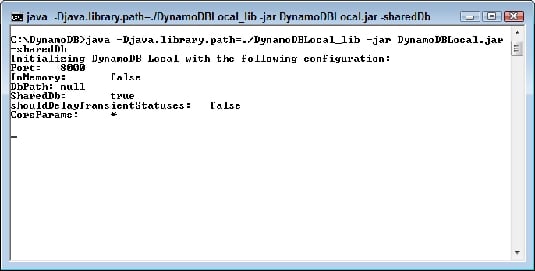

You link your client container to the DB, using -link specifying the name of your DB container and an alias for it inside the client container. This tutorial assumes that you have a basic understanding of the following: the Linux command line, Python3. Once running, the Spring Boot application can connect to to access the local DynamoDB instance. Since AWS charges for DynamoDB, it will be a cost effective way to explore different components of DynamoDB in your local system.
#CONNECT TO LOCAL DYNAMODB TS UPDATE#
When you update your Terraform files adding or deleting resources, Terraform make a comparison between the current state that is in terraform.tfstate file and the new desired state, and then execute the order when you run terraform apply. Serverless-offline: Connecting to local DynamoDB Local gives different results. Running DynamoDB local with it look like this: docker run -p 4572:4572 -p 8080:8080 -p 4569:4569 -e SERVICES = s3,dynamodb localstack. To create the DynamoDB container we need to run this command: docker run -d -p 8000:8000 -network=local-api-network -name dynamo-local amazon/dynamodb-local. Running it locally only requires this command: docker run -p 8000:8000 amazon/dynamodb-local. It spins up a Docker container and makes DynamoDB available on port 8000. After we send the get request again, we are going to be able to see our todo with a totally random id.Part of the reason for its popularity is that Python also has a Web framework which enables us to develop WEB API's and Web Apps. We are going to get a confirmation that our todo has been successfully added to our database. Next, I'm going to paste into JSON, so this is going to be a todo with a content of "Test if adding items to the table actually works." Next up, I'm going to select a body of the request to be a JSON. In any case, if I send a get request to our endpoint, I am going to get all the to-the-items that we have in our database. You can even create your own client if you want to. Insomnia is a REST client that I just happen to use, but honestly you can test your API in anything that allows you to send HTTP requests. In order to test our API, we are going to use Insomnia. After a successful deployment, we can test our updated API.

Open up the terminal and run cdk deploy in order to deploy those changes to AWS. Since we are using await over here, we are going to add that promise at the end of the function. We are also going to send a todo string so I can just add it over here, todo = "todo" or I can just remove that since both key and value have exactly the same name, which is todo.
#CONNECT TO LOCAL DYNAMODB TS CODE#
For now, I'm going to hard code it to a totally random id and we are going to fix that in the next lessons. An item is going to be an object with two feet. This is the environment variable that is being passed into this function. Just a quick reminder, this table name comes from the process.env table name. The first one is exactly the same as in get-all-todos so you can just copy and paste that.

This is going to take an object with two props. Afterwards, we have to call the put method with this object and then we can get the promise. We can see that in order to put a new item in DynamoDB, we need to create the params object which is going to have the table name and also the item that we would like to put in. Here we can see that put is going to either create a new item or if the item already exists, it is going to be replaced. Here we can see that in order to create a new item, we can use the put method. In order to then how can we implement that in order to store data in DynamoDB, we can take a look at this DynamoDB DocumentClient cheat sheet once more. Let's jump to the add-to-the-item effort. Whenever this Lambda function is going to receive a get request, we are going to call it the get-all-todos, but whenever we send a post request to this Lambda function, we are going to call it the add-to-the-item with the data that we got from the request body. The source code for this lesson contains a slightly updated Lambda function. Currently, we are able to get all the todos and next stop, we are going to implement the add-to-the-item functionality. Instructor: It's time to add some extra features to our Lambda function.


 0 kommentar(er)
0 kommentar(er)
